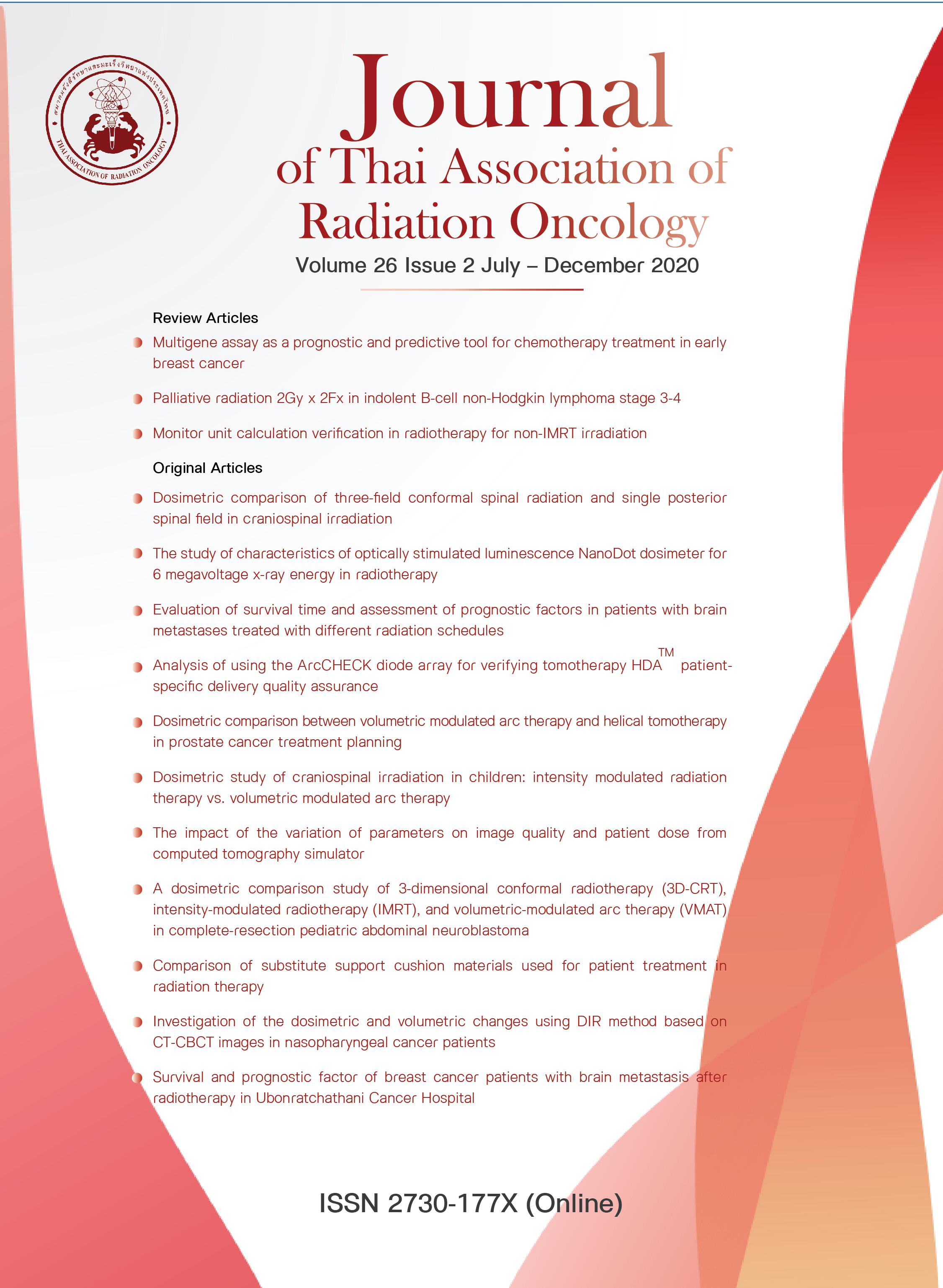A Dosimetric Comparison Study of 3-Dimensional Conformal Radiotherapy (3D-CRT), Intensity-Modulated Radiotherapy (IMRT), and Volumetric-Modulated Arc Therapy (VMAT) in Complete-Resection, Pediatric, Abdominal Neuroblastoma
Keywords:
pediatric neuroblastoma, dosimetric study, 3D-CRT, IMRT, VMATAbstract
Background: Advanced radiotherapy techniques—intensity-modulated radiotherapy (IMRT) and volumetric-modulated arc therapy (VMAT)—deliver low peripheral radiation doses but full doses to desired target volumes and shortening treatment. However, potential late effects related to integral doses and secondary malignancy risks are concerned.
Objective: To compare the dosimetries of 3-Dimensional Conformal Radiotherapy (3D-CRT), IMRT and VMAT in terms of tumor coverage and organ-at-risk (OAR) sparing in neuroblastoma.
Materials and Methods: Patients aged 1 month–15 years, had completely resected high-risk abdominal neuroblastoma, and received radiotherapy. Treatment planning was reperformed for 3D-CRT, IMRT, and VMAT. Patients were divided into 2 subsgroups; radical nephrectomy and non-radical nephrectomy groups then dosimetric data were analyzed.
Results: Among 3D-CRT, IMRT and VMAT, V95% constraint, mean homogeneity indexes and integral doses were not significantly different. Conformity indexes were statistically lower for IMRT and VMAT than 3D-CRT. In the non-radical-nephrectomy group, IMRT and VMAT were superior to 3D-CRT in terms of V18Gy to ipsilateral kidneys and contralateral kidneys. In the radical-nephrectomy group, V18Gy of contralateral kidneys was within dose constraint for 3/4 patients with 3D-CRT but all patients with IMRT and VMAT. Mean V15Gy of liver volume were significantly different among 3 techniques, but V8Gy did not show significant difference. The means for D80% of the spine were not significantly different. Overall passing rates were 12.55% (3D-CRT), 62.5% (IMRT) and 87.5% (VMAT).
Conclusions: IMRT and VMAT had superior OAR sparing (especially the kidneys), without compromising target coverage, than 3D-CRT in all cases.
References
Davidoff AM. Neuroblastoma. Semin Pediatr Surg. 2012;21:2–14.
Monclair T, Brodeur GM, Ambros PF, Brisse HJ, Cecchetto G, Holmes K, et al. The International Neuroblastoma Risk Group (INRG) staging system: An INRG Task Force report. J Clin Oncol. 2009;27:298–303.
Ferris MJ, Danish H, Switchenko JM, Deng C, George BA, Goldsmith KC, et al. Favorable Local Control From Consolidative Radiation Therapy in High-Risk Neuroblastoma Despite Gross Residual Disease, Positive Margins, or Nodal Involvement. Int J Radiat Oncol Biol Phys.2017;97:806–12.
Neglia JP, Friedman DL, Yasui Y, Mertens AC, Hammond S, Stovall M, et al. Second malignant neoplasms in five-year survivors of childhood cancer: Childhood cancer survivor study. J Natl Cancer Inst. 2001;93:618–29.
Paulino AC, Ferenci MS, Chiang KY, Nowlan AW, Marcus RB Jr. Comparison of conventional to intensity modulated radiation therapy for abdominal neuroblastoma. Pediatr Blood Cancer. 2006;46:739–44.
Ducassou A, Gambart M, Munzer C, Padovani L, Carrie C, Haas-Kogan D, et al. Langzeittoxizität nach Strahlentherapie des lokalisierten Neuroblastoms im Kindesalter: Ergebnisse der NB90- und NB94-Studien. Strahlenther Onkol. 2015;191:604–12.
Park Y, G. Kreissman S, B. London W, Naranjo A, Cohn S, Hogarty M, et al. A phase III randomized clinical trial (RCT) of tandem myeloablative autologous stem cell transplant (ASCT) using peripheral blood stem cell (PBSC) as consolidation therapy for high-risk neuroblastoma (HR-NB): A Children’s Oncology Group (COG) study. J Clin Oncol. 2016;34:LBA3–LBA3.
Bansal A. Is VMAT Planning Feasible in Pediatric Neuroblastoma? Cancer Ther Oncol Int J. 2017;6:6–11.
Ślosarek K, Osewski W, Grządziel A, Radwan M, Dolla Ł, Szlag M, et al. Integral dose: Comparison between four techniques for prostate radiotherapy. Reports Pract Oncol Radiother 2015;20:99–103.
D’arienzo M, Masciullo S, Sanctis V, Osti M, Chiacchiararelli L, M Enrici R. Integral Dose and Radiation-Induced Secondary Malignancies: Comparison between Stereotactic Body Radiation Therapy and Three-Dimensional Conformal Radiotherapy. Int J Environ Res Public Health. 2012;9:4223–40.
Beneyton V, Niederst C, Vigneron C, Meyer P, Becmeur F, Marcellin L, et al. Comparison of the dosimetries of 3-dimensions Radiotherapy (3D-RT) with linear accelerator and intensity modulated radiotherapy (IMRT) with helical tomotherapy in children irradiated for neuroblastoma. BMC Med Phys. 2012;12:2.
Haas-Kogan DA, Swift PS, Selch M, Haase GM, Seeger RC, Gerbing RB, et al. Impact of radiotherapy for high-risk neuroblastoma: A Children’s Cancer Group study. Int J Radiat Oncol Biol Phys. 2003;56:28–39.
Bölling T, Willich N, Ernst I. Late effects of abdominal irradiation in children: A review of the literature. Anticancer Res. 2010;30:227–32.
Nazmy MS, Khafaga Y. Clinical experience in pediatric neuroblastoma intensity modulated radiotherapy. J Egypt Natl Canc Inst. 2012;24:185–9.
Mayfield JK, Riseborough EJ, Jaffe N, Nehme ME. Spinal deformity in children treated for neuroblastoma. J Bone Joint Surg Am. 1981;63:183–93.
Paulino AC, Fowler BZ. Risk factors for scoliosis in children with neuroblastoma. Int J Radiat Oncol Biol Phys. 2005;61:865–9.
Hall EJ, Wuu CS. Radiation-induced second cancers: the impact of 3D-CRT and IMRT. Int J Radiat Oncol. 2003;56:83–8.
Karlsson P, Holmberg E, Samuelsson A, Johansson KA, Wallgren A. Soft tissue sarcoma after treatment for breast cancer—A Swedish population-based study. Eur J Cancer. 1998;34:2068–75.
Nguyen F, Rubino C, Guerin S, Diallo I, Samand A, Hawkins M, et al. Risk of a Second Malignant Neoplasm After Cancer in Childhood Treated With Radiotherapy: Correlation With the Integral Dose Restricted to the Irradiated Fields. Int J Radiat Oncol. 2008;70:908–15.
Bansal A. Is VMAT Planning Feasible in Pediatric Neuroblastoma? Cancer Ther Oncol Int J. 2017;6:6–11.
Downloads
Published
How to Cite
Issue
Section
License
บทความที่ได้รับการตีพิมพ์เป็นลิขสิทธิ์ของวารสารมะเร็งวิวัฒน์ ข้อความที่ปรากฏในบทความแต่ละเรื่องในวารสารวิชาการเล่มนี้เป็นความคิดเห็นส่วนตัวของผู้เขียนแต่ละท่านไม่เกี่ยวข้องกับ และบุคคลากรท่านอื่น ๆ ใน สมาคมฯ แต่อย่างใด ความรับผิดชอบองค์ประกอบทั้งหมดของบทความแต่ละเรื่องเป็นของผู้เขียนแต่ละท่าน หากมีความผิดพลาดใดๆ ผู้เขียนแต่ละท่านจะรับผิดชอบบทความของตนเองแต่ผู้เดียว




